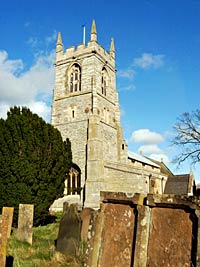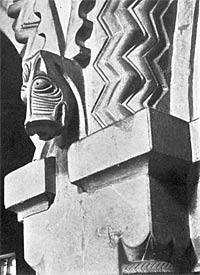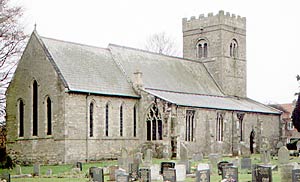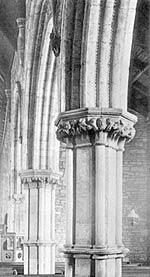< Previous | Contents | Next >
The Dragon on the Norman Arcade
SOUTH COLLINGHAM. A delightful neighbour for North Collingham, it has gabled houses, wayside lawns, overhanging trees, and winding roads revealing odd corners of unexpected charm. On the three-cornered green is an ancient elm 17 feet round its trunk, which is now a mere shell with rustic poles filling the gap between its yawning edges.

South Collingham church in 2004.
© Copyright Christine Hasman and licensed for reuse under this Creative Commons Licence

Norman decorated corbel.
Perhaps its most charming spot is where the church stands in a garden of roses and shrubs, with beech and sycamore trees shading the velvet lawn; it is a beautiful churchyard lovingly tended. From one of its gates we see a pretty group of thatched cottages, and a holly arch frames a picture of the rectory garden, where a splendid oak has a wonderful spread of branches.
The church is neat and lovely in and out, with old and new happily blended. Some of its oldest work is still its chief possession. Exceptionally fine is the Norman arcade of the nave with rich mouldings and carved capitals, and an extraordinary corbel showing the head of a dragon-like creature with the bearded face of a man in its wide-open mouth, the face seen only when we stand below the corbel. The head of a man with his tongue out (as if at the beast) looks across the nave from the English arcade of the 13th century.
The tower is 13th and 15th century. It is a charming bit of the church inside, with its cream walls, its rows of benches, and a lovely arch with detached pillars. The massive font is 13th century and there are three old piscinas. In the 13th century doorway through which we enter hangs a splendid door, which is part of the excellent modern woodwork throughout the church. The benches have traceried ends and some linenfold, the pulpit has carving of vines, and the nave roof has floral bosses. A little old timber is in the roof of the north aisle.
Most of the windows are 15th century, and corbel heads with a striking family likeness adorn them outside. One of them glows with life and rich colour illustrating the 104th Psalm with scenes of night and day and the Providence of God. One angel holds a golden sun and one the crescent moon; there are birds in trees, reapers in the cornfield, grapes in the vineyard, purple hills and snowclad mountain tops, a stream running through green pastures, sheep grazing, cattle drinking, a heron in the water and a swan by her nest; while a great owl is flying above the forest trees in the night sky, and a lion and its mate are prowling through the land.
Another window shows John the Baptist, Mary Magdalene with Magdalen College in the background, and the vision of St John with the seven golden candlesticks and the seven stars. The peace window to 16 men shows a group with fighting saints, including David and Joan of Arc. The brass tablet to their memory is engraved with a rose, of which the petals and the centre are set with nine actual badges of their regiments.
The Coloured Walls

South Leverton church in 2001.
SOUTH LEVERTON. Gay gardens add to its charm, and its wayside church will not let us pass it by. It has grown old graciously, and stands in a lovely churchyard.
Its high unbuttressed tower is mainly Norman, with 15th century battlements, and is charming inside, where its pointed arch opens to the nave and the lovely glass of its 13th century lancet sheds a rainbow light on the great Norman font. The window shows Our Lord blessing the children, and is in memory of Maria Overend, whose gifts helped the restoration of the church at the close of last century.
One of the finest possessions of the church is the great Norman doorway, its detached shafts supporting an arch with handsome zigzag enriched with sunflower pattern. It frames a modern door with beautiful hinges, and as it opens to let us in the walls are seen like masses of mosaic, tinted buff, orange, green, and gold.

Nave arcade.
The 13th century nave arcades have pillars of grouped shafts crowned by foliage capitals, and among the corbels are two pairs of curious animals seeming to be fighting. Under the south aisle roof inside is a huge gargoyle-like head with staring eyes and open mouth.
The chancel is made new, but in its side walls are eight 13th century lancets.
A tapering stone with traces of carving is the oldest possession of the village, for it is believed to have been the lid of a Roman coffin. A floorstone with a cross is only two feet long, and the fragment of another ancient stone has crude carving of feet and a shroud. The chalice is Elizabethan, and three bells are 17th century.
A pleasant house called the Priory has an old gabled end whose walls, four feet thick, may be part of a monastic building. On the edge of the village is a derelict windmill.
